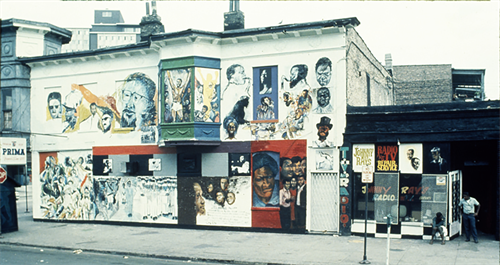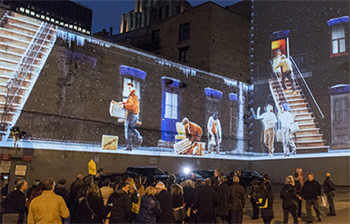Artists and community groups in Chicago harness creativity to shed light on issues of equity.

96 Acres Project, Facebook
96 Acres Project's "Not Just Another Day" examines issues of incarceration using power-washed "reverse graffiti" messages.
Art in Chicago is not confined to the museums. In fact, artists engage with urban environments all around us. In the conversation below, four of Chicago’s public art leaders open up about the projects that inspire them and how artists drive discussions of equity.
On Thursday, August 2nd from 5:00 to 7:00 pm, MPC will host its Urban Think & Drink: Creativity, Arts and Economic Vitality, a thought-provoking evening with wine, snacks and lively conversation.
In anticipation of our upcoming Think & Drink, here's a preview of the thoughts of our talented artist panelists: Paola Aguirre, founder of Borderless Studio/Workshop, Lynn Basa, founder of The Corner Project, Tiff Beatty, founder of "Art is Bonfire", and Faheem Majeed, former Executive Director and Curator for the South Side Community Art Center.
Tell us about a place where art is hiding in Chicago.

Art: Francisco Mendoza; Photo: Flickr user MBA Photography
CTA Pink Link 18th Street Station
Tiff Beatty: If you don't take public transportation or pay attention to what's happening in and around el train stations, you're missing out on some of the coolest public artwork in the city. The Green Line (Indiana) station in my neighborhood is a great example. On my daily commute, I am exposed to photographs by Tonika Johnson that remind me of the beauty in the nuance of life on the south side. The photographs remind me of people I know in real life. Some I likely do. There's a photo of a boy getting lined in a barbershop that I swore was my godson for at least a week!
Faheem Majeed: In addition to all the amazing artists in Chicago, the city is also buzzing with amazing arts organizations. Whether it is the SkyART in South Chicago, Project Onward in Bridgeport, Children’s Museum of Art and Social Justice in Pilsen, 96 Acres Project in Little Village, TRACE in Englewood, BUILD Chicago in Austin, or South Side Community Art Center in Bronzeville the city is rich with culture. These organizations have consistently supported Chicago's arts, artists and communities, often times with meager funding and little support.
Where are artists lending voice to issues of equity in Chicagoland?
Lynn Basa: My studio is in a majority Hispanic neighborhood and through The Corner Project I’ve gotten involved with the Logan Square Neighborhood Association, an old-school activist community organizing group that is still going strong. What I learn from them guides the choices I make for what The Corner Project will focus on. I’m bringing this up to say that this kind of cross-influencing is going on all over Chicago between artists who are committed to their communities. It’s inevitable (I hope) that we eventually seek to connect with groups of other people who are working for the benefit of that community.
Paola Aguirre: I admire very much the work of Maria Gaspar, and her 96 Acres Project. I love that this project is not always visible in the way that we are used to seeing public art. It's documented, but it becomes visible when there are people making it. It's collaborative, inclusive, meaningful and beautiful. I love this sidewalk piece—a power wash performance, a reverse graffiti—out of the Cook County Jail, located in the heart of Little Village, in collaboration with youth program at the National Museum of Mexican Art. (See video of “Not Just Another Day” project.)
The community-based mural movement was pioneered in Chicago. Tell us about a mural or other piece of public art in Chicago that has made an impact on you and your work.

Photo: City of Chicago
Wall of Respect” (1967) in Chicago’s south side pioneered the Community Mural Movement.
Faheem Majeed: That’s easy. Chicago plays a significant role in the history of public murals. "Wall of Respect" (1967) was created on the corner of 43rd and Langley. It marked the beginning of the the Community Mural Movement in which every aspect of the design and creation was influenced by the surrounding community. The wall had images of black heroes and sheroes and was facilitated by the Visual Arts Workshop of the Organization of Black American Culture (OBAC). These men and women thought it was important to highlight positive and strong images of black people in a time when the media was not. The Wall of Respect became a destination for musicians, poets, and community gatherings. In 1971, the mural and the building it was on burned down and although it no longer remains, it legacy has had a great impact on a multitude of artists. For me, it is a shining example of how art can be both beautiful and act as a platform for community and engagement.
Lynn Basa: Seeing Culture in Action in 1993 transformed how I thought about public art and my place as an artist in the world. Instead of expecting the community to come to the art, it embedded artists in communities to create work with the people who lived there. It was curated by Mary Jane Jacob and considered Chicago as an “urban laboratory” with a focus on “pressing social and political issues.” Artists collaborated with candy factory workers, kids in gangs, people with AIDS. Some of the organizations it spawned still exist, like Street-Level Youth Media. To paraphrase Mary Jane Jacob, it opened up the art process to let the public be part of that process. It took years for that way of thinking to seep into my way of making art, but it finally “took.” The Corner Project is the result of that seed having been planted all of those years ago by Culture in Action.
What is a city that you love to travel to because of its great public art, and what can Chicago learn from that place?

Photo: Montréal en Histoires
City of Memories projection in Montreal
Paola Aguirre: Montreal has been in my recent travels and I loved how their public art activates public space, but it also has a strong art and architecture mix. For me, public art is more powerful when you allow others to interact with it—when it engages people spatially, when people can touch, feel textures, explore under, on the side, create their own visual and narrative reading. For their 375th Anniversary, the City of Montreal had this project called City of Memories—projections in public spaces in the downtown area or their Luminotherapie ("Light Therapy") festival.
Tiff Beatty: I am interested in the relationship between creativity, fire (and other natural elements), and public spaces. As founder and host of Art Is Bonfire, Chicago’s only bonfire cypher, I am hugely inspired by bonfires on the beach in cities like Seattle and San Francisco. Art Is Bonfire is the only place I have witnessed Chicagoans roasting and tasting s’mores, while others practice releasing emotional baggage, dropping written words and lyrical spoken word verses in the fire, many for the first time. Art Is Bonfire happens four times a year. For Chicago’s sake, I wish it happened more!
Want to hear more? Join us as we continue the conversation in August!
Paola Aguirre, Lynn Basa, Tiff Beatty and Maheem Majeed will lead a lively conversation about the role of the arts in promoting economic vitality on August 2nd, 2018 from 5:00 to 7:00 at MPC's Urban Think & Drink: Creativity, Arts and Economic Vitality. Join us!
Paola Aguirre is founder of urban design and research practice Borderless Studio/Workshop and featured designer at Jane Addams Hull-House exhibition “Claiming Space: Creative Grounds and Freedom Summer School”, which utilizes interactive mapping to visualize Chicago Public School closures and reflect on the social and economic consequences of school closings. Paola is also an active educator and teaches in the Department of Architecture at the School of the Art Institute of Chicago.
Lynn Basa is an artist, author and founder of The Corner Project in Chicago’s Avondale neighborhood. Basa uses art as a tool for community engagement and advocates for policies which protect community assets.
Tiffanie Beatty is Associate Director of Programming at the Chicago Humanities Festival and founder of “Art Is Bonfire.”
Faheem Majeed is Former Executive Director and Curator for the South Side Community Art Center. His works explore themes of marginalization and synthesize making, curation, performance and community organizing, approaching art as a platform for change
---------------------------------
Kaitlin Cernak is Marketing and Communication Intern at Metropolitan Planning Council and Master in Urban Planning and Policy candidate at University of Illinois at Chicago.